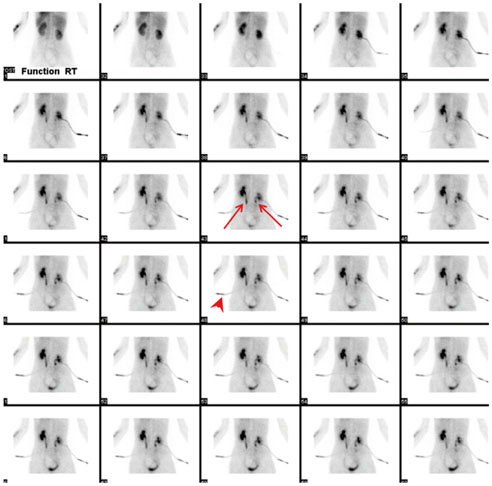J Korean Soc Radiol.
2016 Nov;75(5):410-414. 10.3348/jksr.2016.75.5.410.
A Case of a Desmoid Tumor with an Ureterotumoral Fistula Detected on Renal Scintigraphy
- Affiliations
-
- 1Department of Radiology, Soonchunhyang University Cheonan Hospital, Cheonan, Korea.
- 2Department of Internal Medicine, Soonchunhyang University Cheonan Hospital, Cheonan, Korea.
- 3Department of Nuclear Medicine, Soonchunhyang University Cheonan Hospital, Cheonan, Korea. c91300@schmc.ac.kr
- KMID: 2355997
- DOI: http://doi.org/10.3348/jksr.2016.75.5.410
Abstract
- Desmoid tumors are rare benign tumors with aggressive fibroblastic proliferation. Although desmoid tumors do not metastasize, they have locally aggressive features and can cause a urinary fistula. Here, we report a case of a 35-year-old woman with Gardner syndrome who was diagnosed with an intra-abdominal desmoid tumor 1 year previously and who presented with a newly developed cystic mass lesion on a computed tomography scan. The cystic mass lesion was clinically diagnosed as an urinoma from the right ureterotumoral fistula; thus, surgical resection of the mass lesion was planned. However, Tc-99m diethylenetriamine pentaacetic acid renal scintigraphy revealed bilateral ureterotumoral fistulas; hence, the treatment plan was changed to conservative management.
MeSH Terms
Figure
Reference
-
1. Escobar C, Munker R, Thomas JO, Li BD, Burton GV. Update on desmoid tumors. Ann Oncol. 2012; 23:562–569.2. Lath C, Khanna PC, Gadewar SB, Agrawal D. Inoperable aggressive mesenteric fibromatosis with ureteric fistula. Case report and literature review. Eur J Radiol. 2006; 59:117–121.3. Kim DU, McQuinn G, Lin E, Lee M. Renographic demonstration of desmoid tumor-ureteral fistula. Clin Nucl Med. 2016; 41:44–45.4. Richard HM 3rd, Thall EH, Mitty H, Gribetz ME, Gelernt I. Desmoid tumor-ureteral fistula in Gardner's syndrome. Urology. 1997; 49:135–138.5. Jung RS, Agarwal K, Sood A, Bhattacharya A, Mittal BR. Hybrid SPECT/CT as a diagnostic modality in suspected urinoma with ambiguous planar Tc99m EC renal scintigraphy. Indian J Nucl Med. 2013; 28:254–255.6. Poyraz NY, Ozdemir E, Keskin M, Türkölmez S. Additional value of SPECT/CT to Tc-99m MAG3 renal scintigraphy in the diagnosis of a patient with ureteroileal fistula. Mol Imaging Radionucl Ther. 2012; 21:84–87.7. Jones IT, Jagelman DG, Fazio VW, Lavery IC, Weakley FL, McGannon E. Desmoid tumors in familial polyposis coli. Ann Surg. 1986; 204:94–97.8. Sportiello DJ, Hoogerland DL. A recurrent pelvic desmoid tumor successfully treated with tamoxifen. Cancer. 1991; 67:1443–1446.9. Kabra V, Chaturvedi P, Pathak KA, deSouza LJ. Mesenteric fibromatosis: a report of three cases and literature review. Indian J Cancer. 2001; 38:133–136.
- Full Text Links
- Actions
-
Cited
- CITED
-
- Close
- Share
- Similar articles
-
- A Case of Ileal Mesenteric Desmoid Tumor Resected by Laparoscopic Surgery
- Clinical Experience of Partial Resection of Desmoid Tumor and Perforated Small Bowel for Unresectable Desmoid Tumor with Small Bowel Perforation after IPAA for FAP
- A Case of Nasal Desmoid Tumor
- Desmoid Tumor of the Facet Joint: A Case Report
- A Case of Desmoid Tumor of Rectus Abdominis Muscle Associated with pregnancy




